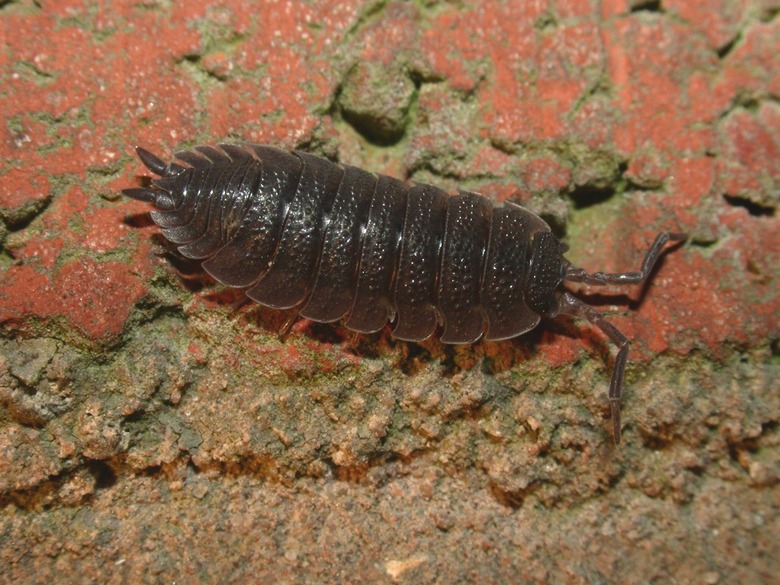What Is The Gray Bug Found Under Bricks And Dirt?
When you pick up bricks, stones, dirt clods and other flat objects in your yard, you'll discover a dark, moist microhabitat underneath, a hidden world with all sorts of life, including gray bugs — invertebrates of different kinds. Note whether they slowly crawl, hop in the air or quickly run away, and what their general body shape and size is, to find out what kind of bug you have uncovered!
Sowbugs or Pillbugs
Sowbugs or Pillbugs
The 1/2-inch-long sowbug slowly crawls away or, if it feels threatened, curls its body into a round ball. Known variously as sowbugs, pillbugs, armadillo bugs, roly-polies or woodlice, these are actually land-living crustaceans, relatives of crabs and lobsters. They're not all the same species, but they all look generally alike. Sowbugs don't curl up tightly like pillbugs or roly-polies do. None of these creatures bite and they aren't toxic or harmful. They're scavengers that eat decaying vegetation and fungi. The body's made up of platelike segments and divided into a head, thorax and abdomen. There are seven pairs of legs. Sowbugs can live more than two years, and they grow by periodically shedding their old hard covering, or exoskeleton.
Springtails or Collembola
Springtails or Collembola
If the gray bugs you find are small and hop vigorously out of your way, you've found springtails, also known as collembola. Generally less than 1/4-inch long, springtails jump by snapping down a forked jumping organ underneath their abdomen. Some springtails can leap 7 inches into the air with one jump, which is 50 to 100 times their body length. Springtails eat decaying organic matter, although a few species will limitedly eat living plant tissue. Springtails come in a variety of colors other than gray.
Silverfish
Silverfish
A quick flash of silvery-gray moving fluidly over the soil means you've uncovered a silverfish. It's found around the world under rocks and in crevices and other sheltered places that hide them during the day. They're active at night. This small insect, from 1/4- to 1/2-inch long, has a carrot-shaped body. Look for the long, paired antennae on the thick end of the body, which is the head, and for three long bristles on the tail end. Silverfish eat a variety of substances, preferring organic materials that originate from plants. They aren't directly harmful to people, but they can become household pests.
True Bugs
True Bugs
Sometimes, usually in the cool months of the year, you'll find gray true bugs in the insect order Hemiptera under bricks, loose soil or yard debris. True bugs have beaklike mouthparts built for sucking up their food. Most often you'll find stink bugs. These are shield-shaped insects about 3/4-inch long. Most stinkbugs feed on plant juices, but some are predatory. If they're annoyed, they emit a strong-smelling fluid which repels possible predators. If you grew plants in the gourd family in your garden — cucumbers, squashes, pumpkins — you might find gray overwintering squash bugs. They're about 5/8-inch long and have raised ridges along the sides of their abdomen that are striped brownish and orange. If you value your next year's squash harvest, destroy these bugs.
References
- Pacific Northwest National Laboratory: What About Pillbugs?
- University of Kentucky Cooperative Extension Service: Kentucky Sowbugs
- North Carolina State University: General Entomology: Collembola
- University of Michigan: Animal Diversity Web: Lepisma Saccharina Silverfish
- University of Kentucky Cooperative Extension Service: Kentucky Insects: Stink Bugs
- University of Minnesota Extension: Squash Bugs in Home Gardens
- Arizona State University: Ask a Biologist: True Bugs
Cite This Article
MLA
Csanyi, Carolyn. "What Is The Gray Bug Found Under Bricks And Dirt?" sciencing.com, https://www.sciencing.com/what-is-the-gray-bug-found-under-bricks-and-dirt-13404709/. 21 July 2017.
APA
Csanyi, Carolyn. (2017, July 21). What Is The Gray Bug Found Under Bricks And Dirt?. sciencing.com. Retrieved from https://www.sciencing.com/what-is-the-gray-bug-found-under-bricks-and-dirt-13404709/
Chicago
Csanyi, Carolyn. What Is The Gray Bug Found Under Bricks And Dirt? last modified March 24, 2022. https://www.sciencing.com/what-is-the-gray-bug-found-under-bricks-and-dirt-13404709/
